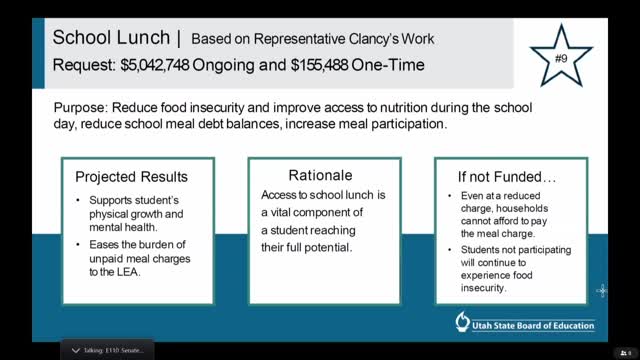State lawmakers propose $5 million to tackle school lunch food insecurity and waste issues
January 28, 2025 | 2025 Utah Legislature, Utah Legislature, Utah Legislative Branch, Utah
This article was created by AI summarizing key points discussed. AI makes mistakes, so for full details and context, please refer to the video of the full meeting. Please report any errors so we can fix them. Report an error »

A bold request for $5 million in ongoing funding for school lunch programs took center stage at the Utah Public Education Appropriations Subcommittee meeting on January 28, 2025. The aim? To combat food insecurity among students and alleviate the financial burden on families struggling to afford reduced lunch options.
The discussion highlighted the pressing issue of food waste, with a 2019 USDA study revealing that nearly 40% of school lunches are discarded, predominantly by students on free or reduced lunch programs. Representative McPherson raised concerns about the effectiveness of the funding, questioning whether a significant portion of the investment might end up in the trash. “$5 million is a huge amount... but if $3 million is going to be thrown into the trash, that is not very encouraging,” he stated, emphasizing the need for a more targeted approach.
Committee members acknowledged the complexities of the situation, with some suggesting a grant program that would allow schools to assess individual student needs rather than applying a blanket policy. Senator Johnson noted the difficulty in determining which students genuinely require assistance, pointing out that hunger can often be invisible. “You can’t tell what hunger looks like,” he remarked, highlighting the challenges in addressing food insecurity effectively.
The conversation also touched on the logistics of meal times in schools, with concerns raised about the limited time students have to eat. Representative Locks pointed out that many children only receive 15 minutes to consume their meals, which may contribute to food waste as students rush through their lunches.
As the committee deliberates on the funding request, the implications of their decisions could significantly impact the lives of many Utah families. The call for a more nuanced approach to school lunch funding reflects a growing recognition of the need to balance financial support with effective solutions to reduce food waste and ensure that every child has access to nutritious meals.
The discussion highlighted the pressing issue of food waste, with a 2019 USDA study revealing that nearly 40% of school lunches are discarded, predominantly by students on free or reduced lunch programs. Representative McPherson raised concerns about the effectiveness of the funding, questioning whether a significant portion of the investment might end up in the trash. “$5 million is a huge amount... but if $3 million is going to be thrown into the trash, that is not very encouraging,” he stated, emphasizing the need for a more targeted approach.
Committee members acknowledged the complexities of the situation, with some suggesting a grant program that would allow schools to assess individual student needs rather than applying a blanket policy. Senator Johnson noted the difficulty in determining which students genuinely require assistance, pointing out that hunger can often be invisible. “You can’t tell what hunger looks like,” he remarked, highlighting the challenges in addressing food insecurity effectively.
The conversation also touched on the logistics of meal times in schools, with concerns raised about the limited time students have to eat. Representative Locks pointed out that many children only receive 15 minutes to consume their meals, which may contribute to food waste as students rush through their lunches.
As the committee deliberates on the funding request, the implications of their decisions could significantly impact the lives of many Utah families. The call for a more nuanced approach to school lunch funding reflects a growing recognition of the need to balance financial support with effective solutions to reduce food waste and ensure that every child has access to nutritious meals.
View full meeting
This article is based on a recent meeting—watch the full video and explore the complete transcript for deeper insights into the discussion.
View full meeting

